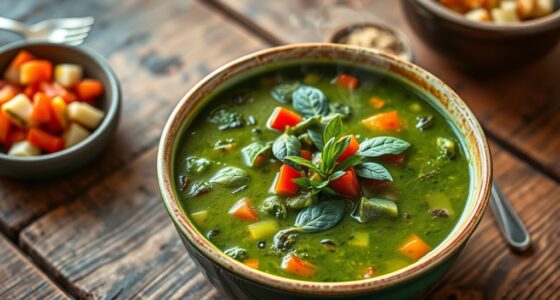Legumes are a key part of sustainable diets because they provide plant-based protein, fiber, and essential nutrients while requiring less water and fertilizer than other crops. They help reduce greenhouse gas emissions and improve soil health, making farming more eco-friendly. Plus, they can replace meat in your meals, supporting healthier and more sustainable food choices. To discover practical ways to include more legumes and maximize their benefits, explore further.
Key Takeaways
- Legumes are plant-based proteins that support sustainable diets by replacing meat and reducing environmental impact.
- They require less water, fertilizer, and land, contributing to eco-friendly agriculture and lower greenhouse gas emissions.
- High in fiber and nutrients, legumes promote health, satiety, and help prevent chronic diseases.
- Incorporating legumes into meals enhances diversity and aligns with resource-efficient, climate-resilient food systems.
- Promoting legume consumption supports global efforts for sustainable, nutritious, and environmentally conscious diets.
Nutritional Benefits of Legumes for Sustainable Living
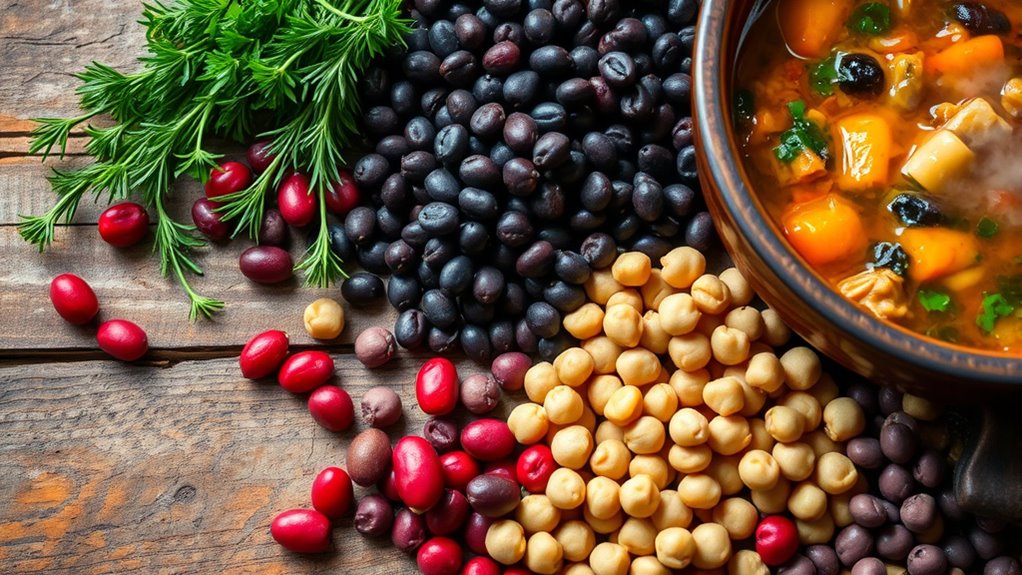
Legumes are a powerhouse of nutrition, making them a vital component of sustainable diets. When you include them in your meals, you gain a rich source of plant-based protein, which helps reduce reliance on animal products. Legumes are packed with fiber, supporting healthy digestion and keeping you full longer. They also provide essential nutrients like iron, folate, and potassium, contributing to overall health. Their low fat content makes them heart-healthy options that can help manage cholesterol levels. Additionally, legumes contain antioxidants that combat inflammation and boost your immune system. By choosing legumes regularly, you not only improve your personal health but also support sustainable food practices that minimize environmental impact. Consuming a variety of legumes can enhance nutrient intake and contribute to raw food diets, which promote the preservation of natural enzymes and nutrients. Incorporating these nutrient-dense foods into your diet benefits both your well-being and the planet. Including legumes in your meals can also lower your overall carbon footprint by reducing the need for resource-intensive animal farming.
Environmental Impact of Legume Cultivation
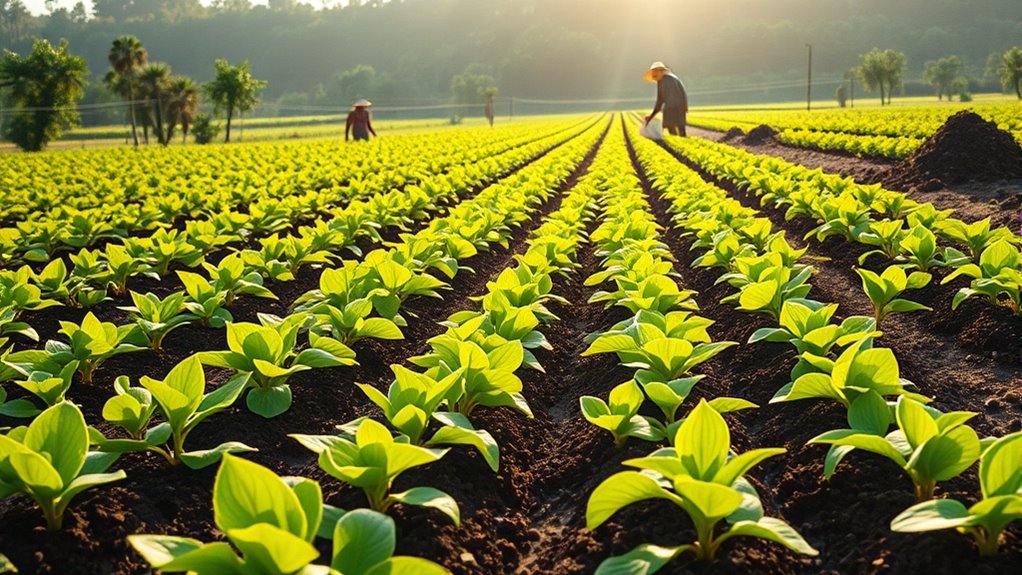
Cultivating legumes offers significant environmental benefits by requiring less water and synthetic fertilizers compared to many other crops. This makes them a sustainable choice for farmers aiming to reduce their ecological footprint. Legumes also fix nitrogen in the soil, decreasing the need for chemical fertilizers. This process enriches soil health and lowers pollution. Additionally, growing legumes can help conserve water resources and reduce greenhouse gas emissions. Incorporating popular no-sugar-added juice brands into sustainable diets can promote healthier hydration options that complement environmentally conscious eating habits. Employing sustainable farming practices such as crop rotation and minimal tillage can further enhance these positive impacts.
Legumes as a Protein-Rich Alternative to Meat
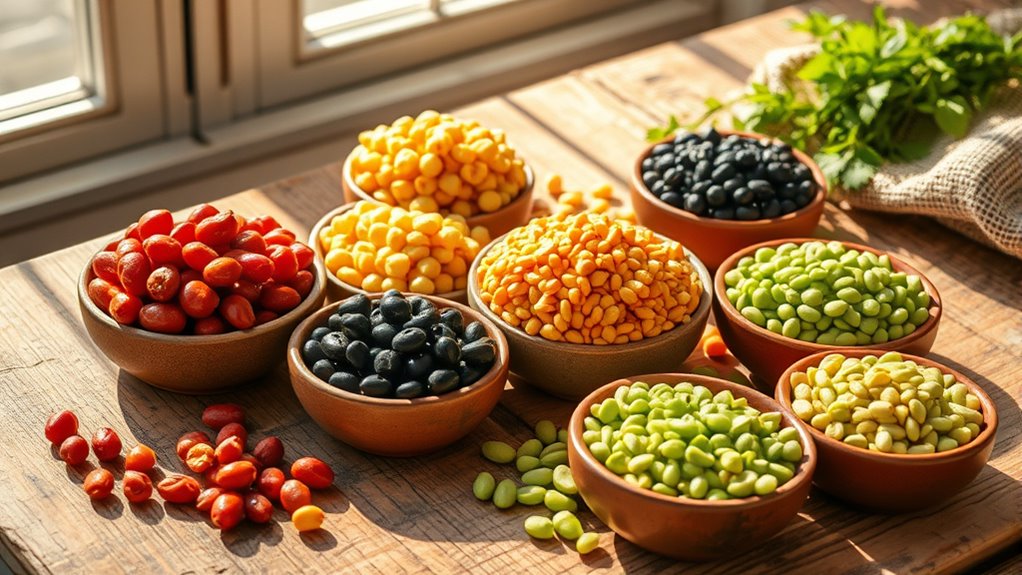
Legumes offer a powerful plant-based protein source that can replace meat in your diet. They also provide essential nutrients like fiber, vitamins, and minerals, supporting overall health. By choosing legumes, you can reduce your environmental footprint while enjoying a nutritious alternative.
Nutritional Benefits of Legumes
Because they are rich in protein, legumes offer a valuable plant-based alternative to meat, making them an essential component of sustainable diets. They also provide essential nutrients that support overall health, such as fiber, vitamins, and minerals. Incorporating legumes into your meals can help you meet daily nutritional needs while reducing reliance on animal products. Additionally, high fiber content in legumes promotes digestive health and helps maintain a feeling of fullness, supporting weight management. Furthermore, keto-friendly ingredients like legumes can be included in a balanced diet to ensure adequate nutrient intake without compromising low-carb goals. Regularly storing dried or canned legumes ensures their long shelf life, making them a reliable food source during emergencies or supply shortages. To maximize their benefits, using rustic kitchen textiles for preparation and storage can add a charming touch to your pantry organization. Incorporating sustainable farming practices when growing legumes can further enhance their environmental benefits and support eco-friendly food systems.
Environmental Impact Reduction
Switching to legumes as a primary protein source considerably reduces the environmental impact associated with meat production. Legumes need less land, water, and energy compared to livestock farming. They also produce considerably fewer greenhouse gases, helping combat climate change. Unlike meat, legumes fix nitrogen in the soil, reducing the need for synthetic fertilizers that pollute waterways. This natural process supports sustainable agriculture and decreases pollution. Moving to plant-based proteins like beans, lentils, and chickpeas can lower your carbon footprint and conserve essential resources. Additionally, soil health is improved when legumes are incorporated into crop rotations, promoting long-term sustainability. The nutritional benefits of legumes include high levels of protein, fiber, vitamins, and minerals, making them a healthy addition to any diet. By choosing legumes over meat, you contribute to a healthier planet while enjoying nutritious, versatile foods. Reducing meat consumption and increasing legume intake is a practical step toward creating a more sustainable and environmentally friendly diet.
Incorporating Legumes Into Everyday Meals
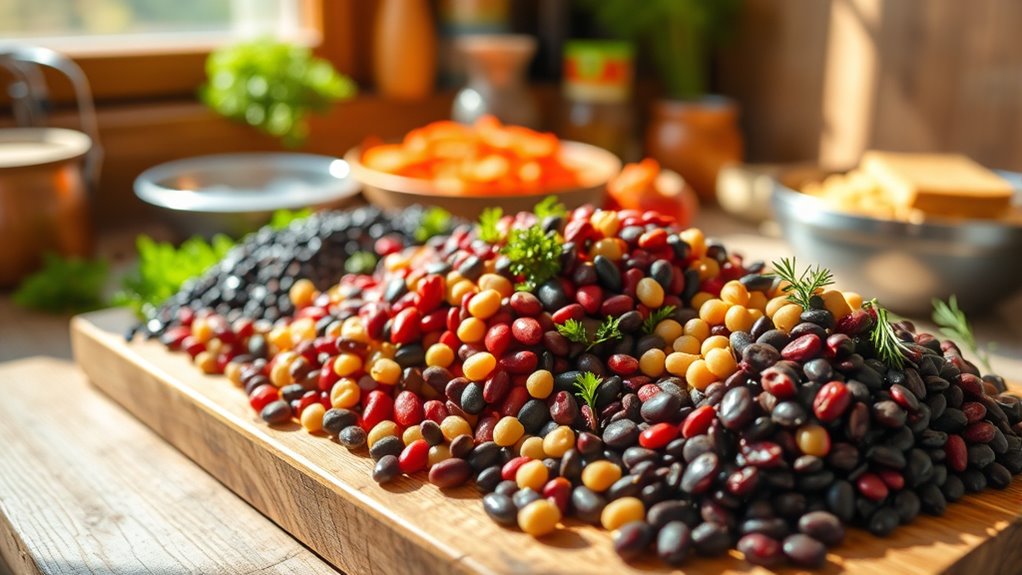
Incorporating legumes into your daily meals is easier than you might think, and it can considerably boost both nutrition and sustainability. Start by swapping beans or lentils for meat in your favorite dishes, like chili or stir-fries. Add chickpeas to salads or blend them into smoothies for extra protein. Prepare large batches of cooked legumes to save time during busy weekdays. Remember to choose necessary cookies for essential functionalities when browsing recipe sites for new ideas.
Here are three ways to make legumes a regular part of your diet:
- Use canned or pre-cooked legumes for quick meal prep.
- Experiment with different seasonings and recipes to keep it exciting.
- Incorporate legumes into snacks, such as roasted chickpeas or hummus spreads. Incorporating legumes with sensory experiences can enhance visual appeal and make dishes more appetizing.
Making small changes like these can notably improve your diet and help the environment.
Challenges and Opportunities in Promoting Legume Consumption
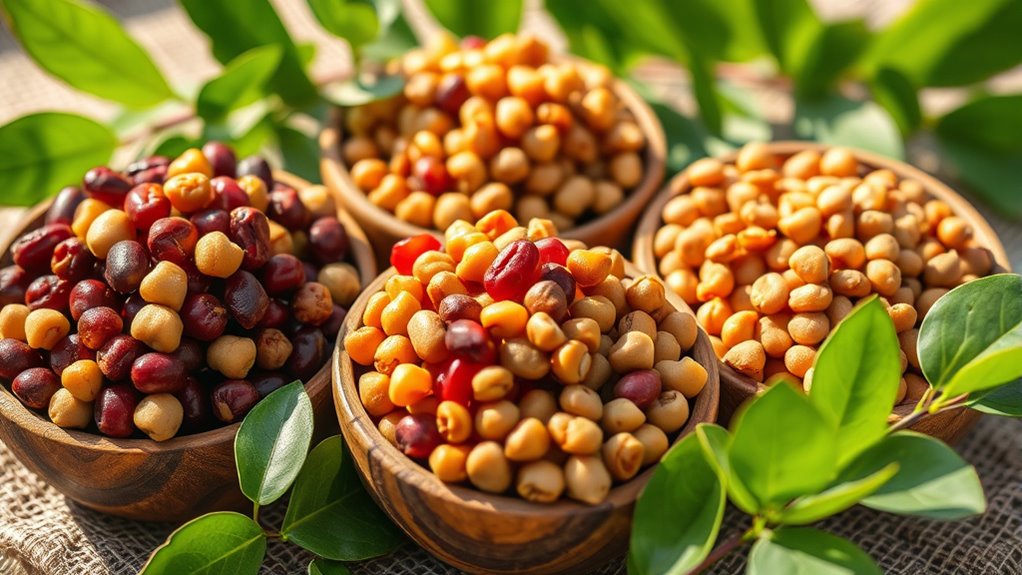
You might face challenges like low consumer awareness and cultural preferences that favor other foods. Agricultural production limits can also restrict availability and affordability of legumes. However, these hurdles present opportunities to educate the public and improve farming practices to promote wider legume adoption. Incorporating multi-functional furniture and vertical storage solutions can also help in creating more accessible spaces for community markets or educational displays, further supporting legume promotion efforts.
Consumer Awareness Barriers
Despite the clear environmental and health benefits, many consumers remain hesitant to embrace legumes regularly. A lack of awareness about their nutritional value, versatility, and long-term benefits fuels this hesitation. You might not realize that legumes can replace meat, reduce your carbon footprint, and improve your heart health. To overcome these barriers, consider these points:
- Limited knowledge about preparing and cooking legumes
- Cultural perceptions and taste preferences
- Misconceptions about digestibility and gas production
Addressing these issues can help you see legumes as a practical, tasty addition to your diet. Increasing awareness through education, recipes, and exposure is key. When you understand their benefits and how easy they are to incorporate, you’re more likely to make legumes a regular part of your meals.
Agricultural Production Limits
What limits the widespread promotion of legumes in agriculture? One major factor is the lack of dedicated farmland, as many farmers prioritize crops with higher market demand or yield. Legumes often require specific growing conditions and longer planting cycles, which can deter farmers seeking quick returns. Additionally, limited access to high-quality seeds and modern farming equipment hampers large-scale production. Pest and disease management also pose challenges, increasing costs and risks for farmers. Moreover, existing crop rotation practices may not prioritize legumes, reducing their integration into farming systems. Crop rotation practices may not always favor legumes, which limits their adoption. Despite these hurdles, opportunities exist through improved crop varieties, better farming techniques, and supportive policies. Addressing these production limits can help expand legume cultivation, making it a more sustainable and accessible protein source globally. Genetic variation can lead to the development of more resilient legume strains, further supporting their growth in diverse agricultural settings.
Cultural Acceptance Challenges
While improving production methods can boost legume availability, convincing consumers to embrace these foods remains a significant hurdle. Cultural preferences, unfamiliarity, and ingrained eating habits often limit legume consumption. To overcome this, focus on these opportunities:
- Education and awareness: Show how legumes fit into diverse cuisines to break stereotypes.
- Recipe innovation: Create appealing, easy-to-prepare dishes that suit local tastes.
- Community engagement: Involve local leaders to promote acceptance and dispel myths.
- Designing cozy spaces: Incorporate elements like vintage decor and rustic lighting to make the idea of incorporating legumes more inviting and familiar in the context of familiar farmhouse bedroom aesthetics.
Future Perspectives on Legumes and Sustainable Food Systems

As the global demand for sustainable food sources grows, legumes are poised to play a pivotal role in shaping future food systems. You’ll see increased investment in breeding programs to develop high-yielding, climate-resilient legume varieties. Innovative farming techniques, such as precision agriculture, will boost productivity while reducing environmental impacts. You might also see legumes integrated into alternative protein products, appealing to consumers seeking sustainable options. Governments and organizations will likely promote policies that encourage legume cultivation and consumption. As awareness of their benefits expands, you’ll have more opportunities to incorporate legumes into diverse diets worldwide. Additionally, the incorporation of seed-based nutrition practices will ensure transparent and privacy-conscious engagement with digital platforms promoting legume-related initiatives. Furthermore, advancements in agricultural sustainability will support the development of practices that optimize resource use and minimize ecological footprints. Emphasizing market research can help identify consumer preferences and drive innovation in legume-based foods. Recognizing the importance of nutritional value in legumes will continue to influence research and development efforts, ensuring these crops meet the evolving health needs of populations. Ultimately, legumes will become central to resilient, environmentally friendly food systems that meet global nutritional needs while minimizing ecological footprints.
Frequently Asked Questions
How Do Legumes Compare to Other Plant-Based Proteins Nutritionally?
When comparing legumes to other plant-based proteins, you’ll find they’re rich in protein, fiber, vitamins, and minerals. Legumes often have higher protein content and better amino acid profiles than grains or nuts. They’re also low in fat and calories, making them a nutritious choice. Incorporate a variety of legumes, like lentils and beans, into your diet to benefit from their unique nutritional strengths and support overall health.
What Are the Main Barriers to Increasing Legume Consumption Globally?
You might find that the main barriers to increasing legume consumption globally include cultural preferences, lack of awareness about their benefits, and limited access in some regions. Additionally, concerns about digestibility and preparation time can discourage people from eating more legumes. Overcoming these obstacles requires education, improved availability, and promoting versatile recipes to make legumes an appealing and convenient choice for everyone.
How Can Legume Farming Be Made More Sustainable?
You can make legume farming more sustainable by adopting crop rotation practices that improve soil health and reduce the need for chemical inputs. Using organic fertilizers and water-efficient irrigation methods also helps. Embracing new technologies like precision agriculture allows you to optimize yields with fewer resources. It’s no use reinventing the wheel, so learning from successful sustainable practices worldwide can accelerate your efforts toward eco-friendly legume farming.
Are There Any Cultural or Regional Preferences Affecting Legume Intake?
You might notice that cultural and regional preferences influence how much legumes you eat. In some areas, legumes are staple foods, while others favor different proteins. These preferences shape your diet choices and availability. Your local cuisine, traditions, and taste preferences play a big role in your legume intake, making it more or less common in your diet. Understanding these cultural factors helps promote more inclusive, sustainable eating habits worldwide.
What Policies Could Incentivize Legume Production and Consumption?
You can support policies that offer subsidies or financial incentives to farmers growing legumes, making them more profitable and attractive. Promoting public awareness campaigns highlights health and environmental benefits, encouraging consumers to buy more legumes. Implementing school meal programs that include legumes can shape eating habits early. Additionally, establishing standards and certifications can boost trust and demand, ultimately increasing both production and consumption of these sustainable crops.
Conclusion
Think of legumes as the quiet heroes of sustainable diets—like a small seed that grows into a mighty tree. By choosing legumes, you’re not just nourishing yourself but also planting the seeds for a healthier planet. With their rich nutrients and low environmental footprint, they’re your secret weapon for change. Embrace legumes daily, and you’ll be helping build a future where food and nature thrive side by side.




